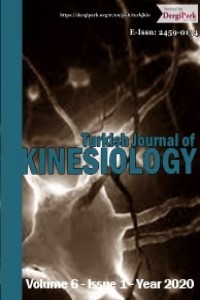The effect of acute high-intensity interval exercise on post-exercise blood pressure in post coronary artery bypass graft surgery patients: a pilot study
The effect of acute high-intensity interval exercise on post-exercise blood pressure in post coronary artery bypass graft surgery patients: a pilot study
___
- ACSM. (2016). The ACSM definition of cardiovascular exercise. Available from: URL: http://healthyliving.azcentral.com/acsmdefinition- cardiovascular-exercise-18723.html.
- Ciolac, E.G., Guimarães, G.V., Bortolotto, L.A., Doria, E.L. and Bocchi, E.A., (2009). Acute effects of continuous and interval aerobic exercise on 24-h ambulatory blood pressure in long-term treated hypertensive patients. Int J Cardiol, 133(3), 381-387.
- Conraads, V.M., Pattyn, N., De Maeyer, C., Beckers, P.J., Coeckelberghs, E., Cornelissen, V.A., Denollet, J., Frederix, G., Goetschalckx, K., Hoymans, V.Y. and Possemiers, N., (2015). Aerobic interval training and continuous training equally improve aerobic exercise capacity in patients with coronary artery disease: the SAINTEX-CAD study. Int J Cardiol, 179, 203-210.
- Costa, E. C., Browne, R. A., Câmara, M., Macêdo, G. A., Lucena, B. E., Vianna, L. C., & Duhamel, T. A. (2022). Immediate post‐exercise blood pressure and arterial stiffness in hypertensive and normotensive older females. J Clin Hypertens, 24(6), 704- 712.
- Currie, K.D., Dubberley, J.B., McKelvie, R.S., & MacDonald, M.J. (2013). Low-volume, high-intensity interval training in patients with CAD. Med Sci Sports Exerc, 45(8), 1436-1442.
- Ghashghaei, F.E., Sadeghi, M., Marandi, S.M., & Ghashghaei, S.E. (2012). Exercise-based cardiac rehabilitation improves hemodynamic responses after coronary artery bypass graft surgery. Arya Atheroscler, 7(4), 151-156.
- Gibala, M.J., & McGee, S.L. (2008). Metabolic adaptations to short-term high-intensity interval training: a little pain for a lot of gain? Exerc Sport Sci Rev, 36(2), 58-63.
- Guiraud, T., Juneau, M., Nigam, A., Gayda, M., Meyer, P., Mekary, S., Paillard, F., & Bosquet, L. (2010). Optimization of high-intensity interval exercise in coronary heart disease. Eur J Appl Physiol, 108(4), 733-740.
- Guiraud, T., Nigam, A., Gremeaux, V., Meyer, P., Juneau, M., & Bosquet, L. (2012). High-intensity interval training in cardiac rehabilitation. Sports Med, 42(7), 587-605.
- Hintsala, H. E., Valtonen, R., Kiviniemi, A., Crandall, C., Perkiömäki, J., Hautala, A., Mäntysaari, M., Alén, M., Ryti, N., Jaakkola, J., & Ikäheimo, T. M. (2021). Central aortic hemodynamics following acute lower and upper-body exercise in a cold environment among patients with coronary artery disease. Sci Rep, 11(1), 2550.
- Kaul, U., & Bhatia, V. (2010). Perspective on coronary interventions & cardiac surgeries in India. Indian J Med Res, 132(5), 543-548.
- Lozano, R., Naghavi, M., Foreman, K., Lim, S., Shibuya, K., Aboyans, V., Abraham, J., Adair, T., Aggarwal, R., Ahn, S. Y., & AlMazroa, M. A. (2013). Global and regional mortality from 235 causes of death for 20 age groups in 1990 and 2010: a systematic analysis for the Global Burden of Disease Study 2010. The Lancet, 380(9859), 2095-2128.
- Mezzani, A., Corrà, U., & Giannuzzi, P. (2008). Central adaptations to exercise training in patients with chronic heart failure. Heart Fail Rev, 13(1), 13-20.
- Michael, S., Graham, K. S., & Davis, G. M. (2017). Cardiac autonomic responses during exercise and post-exercise recovery using heart rate variability and systolic time intervals—a review. Front Physiol, 8, 301.
- Nauman, J., Nilsen, T. I. L., Wisløff, U., & Vatten, L. J., (2010). Combined effect of resting heart rate and physical activity on ischaemic heart disease: mortality follow-up in a population study (the HUNT study, Norway). J Epidemiol Community Health, 64(2), 175-181.
- Pattyn, N., Coeckelberghs, E., Buys, R., Cornelissen, V.A., & Vanhees, L. (2014). Aerobic interval training vs. moderate continuous training in coronary artery disease patients: a systematic review and meta-analysis. Sports Med, 44(5), 687-700.
- Pescatello, L.S., Franklin, B.A., Fagard, R., Farquhar, W.B., Kelley, G.A., & Ray, C.A. (2004). Exercise and hypertension. Med Sci Sports Exerc, 36(3), 533-553.
- Ramezani, A. R., & Heidari, N. (2018). The effect of acute slow resistance exercise on post-exercise blood pressure in active normotensive male recreational athlete. Turk J Sport and Exe, 18(1), 57-63.
- Rossow, L.M., Fahs, C.A., Sherk, V.D., Seo, D.I., Bemben, D.A., & Bemben, M.G. (2011). The effect of acute blood‐flow‐restricted resistance exercise on postexercise blood pressure. Clin Physiol Funct Imaging, 31(6), 429-434.
- Villelabeitia-Jaureguizar, K., Vicente-Campos, D., Senen, A. B., Jiménez, V. H., Garrido-Lestache, M., & Chicharro, J. L. (2017). Effects of high-intensity interval versus continuous exercise training on post-exercise heart rate recovery in coronary heart-disease patients. Int J Cardiol, 244, 17–23.
- Yayın Aralığı: 4
- Başlangıç: 2015
- Yayıncı: Nurtekin Erkmen
Impact of cardiometabolic risk factors on the quality of life of soldiers of Kinshasa
Kiana Ngasa NICAISE, Constant NKIAMA, Gilbert KABANDA, Claude NSINGA, Willy KATOSIA, Aliocha NKODILA, Betty MIANGINDULA, Kintoki VITA
Patterns of resting electrocardiogram of male college track and field athletes
Oluwabusayo Odunayo AKİNBİOLA, Oluwadare OGUNLADE
Naser HEİDARİ, Majid KASHEF, Alireza RAMEZANI, Khosro MINAVAND, Reza GHARAKHANLOU
Effect of plyometric training on improving vertical jump in female footballers (14-17 years old)
Mokkedes Moulay IDRISS, Guebli ABDELKADER, Reguieg MADANİ, Mohammed ZERF, Ali BENGOUA
Wonder Yao NANEVI, Monday MOSES, Emmanuel ANSU GYEABOUR, Robert Junior BOATENG
